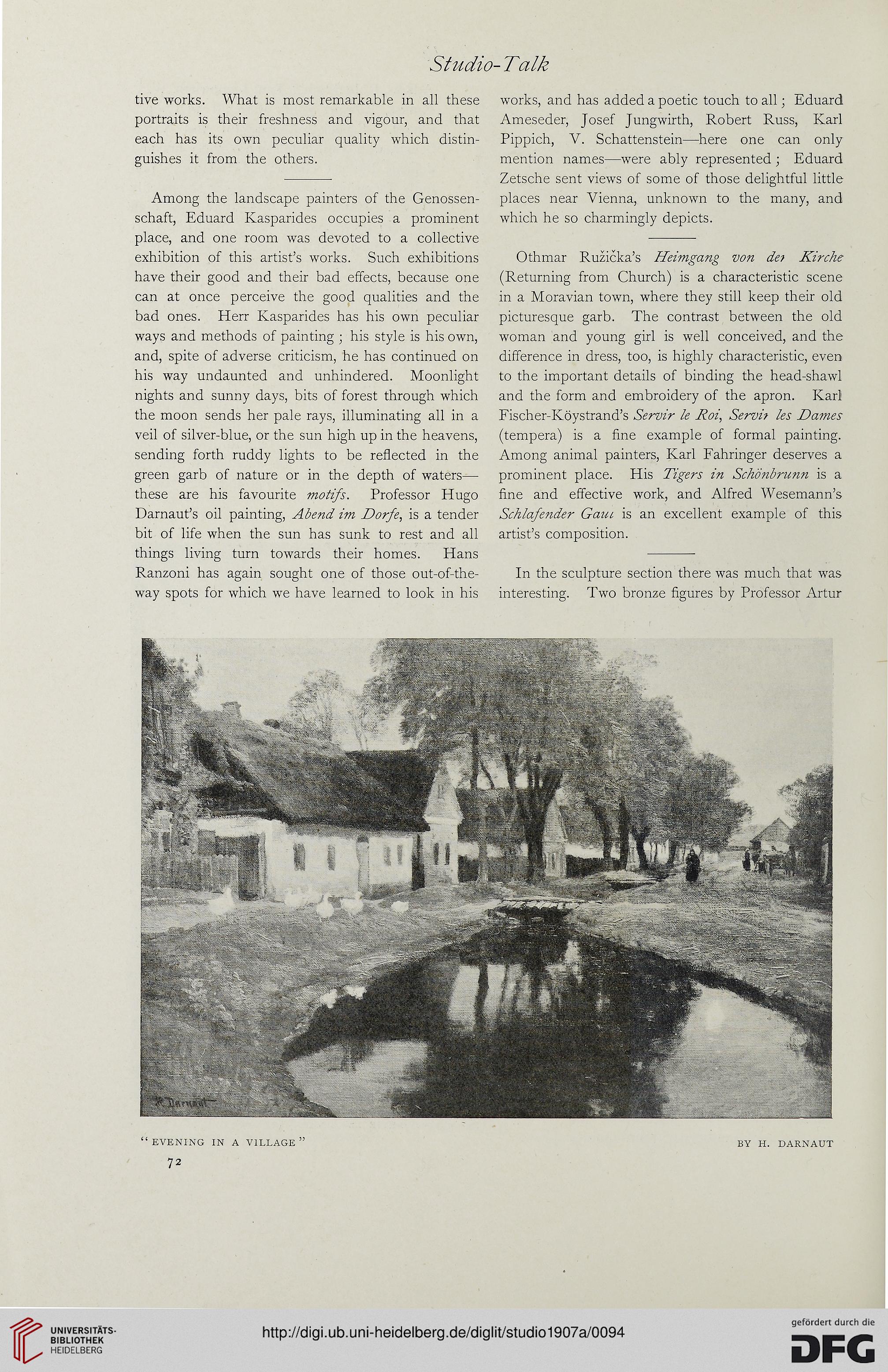Studio-Talk
tive works. What is most remarkable in all these
portraits is their freshness and vigour, and that
each has its own peculiar quality which distin-
guishes it from the others.
Among the landscape painters of the Genossen-
schaft, Eduard Ivasparides occupies a prominent
place, and one room was devoted to a collective
exhibition of this artist’s works. Such exhibitions
have their good and their bad effects, because one
can at once perceive the good qualities and the
bad ones. Herr Ivasparides has his own peculiar
ways and methods of painting ; his style is his own,
and, spite of adverse criticism, he has continued on
his way undaunted and unhindered. Moonlight
nights and sunny days, bits of forest through which
the moon sends her pale rays, illuminating all in a
veil of silver-blue, or the sun high up in the heavens,
sending forth ruddy lights to be reflected in the
green garb of nature or in the depth of waters—
these are his favourite motifs. Professor Hugo
Darnaut’s oil painting, Abend im Dorfe, is a tender
bit of life when the sun has sunk to rest and all
things living turn towards their homes. Hans
Ranzoni has again sought one of those out-of-the-
way spots for which we have learned to look in his
works, and has added a poetic touch to all; Eduard
Ameseder, Josef Jungwirth, Robert Russ, Karl
Pippich, V. Schattenstein—here one can only
mention names—were ably represented ; Eduard
Zetsche sent views of some of those delightful little
places near Vienna, unknown to the many, and
which he so charmingly depicts.
Othmar Ruzicka’s Heimgang von dei Kirche
(Returning from Church) is a characteristic scene
in a Moravian town, where they still keep their old
picturesque garb. The contrast between the old
woman and young girl is well conceived, and the
difference in dress, too, is highly characteristic, even
to the important details of binding the head-shawl
and the form and embroidery of the apron. Karl
Fischer-Ivoystrand’s Servir le Roi, Servi? les Dames
(tempera) is a fine example of formal painting.
Among animal painters, Karl Fahringer deserves a
prominent place. His Tigers in Schonbrunn is a
fine and effective work, and Alfred Wesemann’s
Schlafender Gam is an excellent example of this
artist’s composition.
In the sculpture section there was much that was
interesting. Two bronze figures by Professor Artur
“evening in a village”
BY H. DARNAUT
72
tive works. What is most remarkable in all these
portraits is their freshness and vigour, and that
each has its own peculiar quality which distin-
guishes it from the others.
Among the landscape painters of the Genossen-
schaft, Eduard Ivasparides occupies a prominent
place, and one room was devoted to a collective
exhibition of this artist’s works. Such exhibitions
have their good and their bad effects, because one
can at once perceive the good qualities and the
bad ones. Herr Ivasparides has his own peculiar
ways and methods of painting ; his style is his own,
and, spite of adverse criticism, he has continued on
his way undaunted and unhindered. Moonlight
nights and sunny days, bits of forest through which
the moon sends her pale rays, illuminating all in a
veil of silver-blue, or the sun high up in the heavens,
sending forth ruddy lights to be reflected in the
green garb of nature or in the depth of waters—
these are his favourite motifs. Professor Hugo
Darnaut’s oil painting, Abend im Dorfe, is a tender
bit of life when the sun has sunk to rest and all
things living turn towards their homes. Hans
Ranzoni has again sought one of those out-of-the-
way spots for which we have learned to look in his
works, and has added a poetic touch to all; Eduard
Ameseder, Josef Jungwirth, Robert Russ, Karl
Pippich, V. Schattenstein—here one can only
mention names—were ably represented ; Eduard
Zetsche sent views of some of those delightful little
places near Vienna, unknown to the many, and
which he so charmingly depicts.
Othmar Ruzicka’s Heimgang von dei Kirche
(Returning from Church) is a characteristic scene
in a Moravian town, where they still keep their old
picturesque garb. The contrast between the old
woman and young girl is well conceived, and the
difference in dress, too, is highly characteristic, even
to the important details of binding the head-shawl
and the form and embroidery of the apron. Karl
Fischer-Ivoystrand’s Servir le Roi, Servi? les Dames
(tempera) is a fine example of formal painting.
Among animal painters, Karl Fahringer deserves a
prominent place. His Tigers in Schonbrunn is a
fine and effective work, and Alfred Wesemann’s
Schlafender Gam is an excellent example of this
artist’s composition.
In the sculpture section there was much that was
interesting. Two bronze figures by Professor Artur
“evening in a village”
BY H. DARNAUT
72




